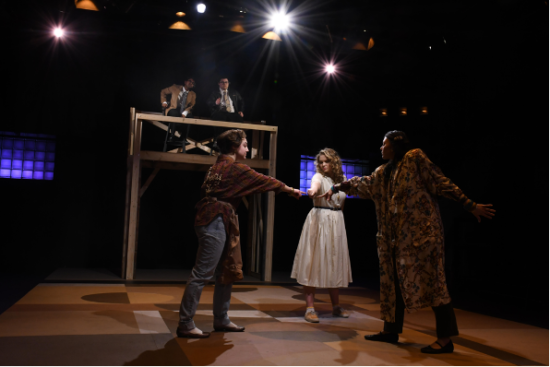First- and second-year students bring family, football and absurdity to the Greystone stage.
USask’s Greystone Theatre never disappoints with an eclectic array of shows throughout the university’s Fall and Winter terms. The upcoming first-and-second-year drama student performance of Kate Benson’s dark comedy, A Beautiful Day in November on the Banks of the Greatest of the Great Lakes, is sure to add to their strong repertoire. Now, before you read on, try saying the play’s title five times fast.
A Beautiful Day in November on the Banks of the Greatest of the Great Lakes – or ABDINOTBOTFOTFL for short, or even “ab-din-ot-bot-fotfull,” as cast member Patrick Lomas has begun to call it – is an eccentric, absurd and assuredly hilarious comedy that looks at how crazy and strenuous family get-togethers can be.
The play follows the Middle-American Wembley family as they go about their Thanksgiving festivities at an absolutely frenetic pace. As the family jumps and bounces around the stage, they are accompanied by both zippy humour and running subtext through the use of a sports play-by-play commentary team.

Lomas plays the sports commentator, Octothorpe (better known as the # symbol to you and I). The actor describes his character as a real “shot-caller,” and said that the play is “not leaning a lot on the literal.”
“I’m [commenting] on the characters’ actions and [my co-announcer, @] is on colour [commentary]. I’m always calling out when people are entering into the dining room, or the living room, or the kitchen, and what they’re doing. @ is filling in on why they’re doing it, why it matters; background information that our listeners might not know.”
Lomas continued to explain that the play is extremely movement heavy, with the set being a “wide open space … [with] some bleachers on one end and the announcer booth raised off the ground.” He also made note of the set’s sport- and 1980s-influenced design: “the ground is painted in this really fun pattern that’s like a mix of hardwood flooring, an elementary school gym and an 80s living room with a lot of browns and beiges.”
Natasha Martina, USask professor of drama and veteran director of Greystone Theatre productions, elaborated on the minimal set design.
“This play is meant to be done without a single prop,” she said. “The only set piece is the announcer’s stand, so literally there’s no set. There’s no props.”
Martina also explained that in this play, “nothing is literal.” The physicality of the play is larger than life, and adds an exciting and dynamic element to the performance. Taking this approach was a potential risk, considering the director was working with untrained students, but Martina was able to find solid solutions to this problem by building a cohesive cast that worked on instinct, experimentation and trust.
“There are 17 first-years and second-years, and I have to say I was really delighted to see all the offers that they brought to the table in regards to ‘what if we try this or what if we try that?’ I try to plant seeds with them and then I let them kind of carve out what works best for them,” she said. “I always find that’s the best way to work, because then it’s coming from their instinct and they can own it.”
All-in-all, Martina characterized the play as a bit of a parody on the classic Thanksgiving dinner. She described the play’s 80s setting as a “cheesy era” that only fed into the social commentary of the show.
“The play is supposed to be set in the idea of the present but this cast of characters is [living] in the past,” Martina explained. “There’s the same [old] criticism about certain family members … coming late, or not doing their part. [It’s] always the same people that are in the kitchen doing the cooking, which is the idea of what the whole matriarchal structure is, you know, again in the kitchen, doing all this work,” she continued. “But then it’s juxtaposed with the sports metaphor, which is the idea of a male dominated society and the patriarchy. I think what Kate Benson [the playwright] is going for is that contrast.”
Abraham Galman, a third-year theatrical design student, served as the lead costume designer for the show. He explained some of the difficulties that came with designing for a show where actors had to jump, run, and spin across the stage without having their costumes fall to shreds.
“We had to cut back on a lot of detail,” Galman said. We can’t necessarily have people with high hair or massive costumes because it would be heavy and hard to move in.”
Fortunately for Galman, the cast seemed eager to make his job, if anything, just a touch easier by maintaining a very “go with the flow” attitude.
He specifically noted the character, Trifle, played by Rebecca Spilchak, as fun to design: “She’s wearing this kind of horrendously patterned shirt with an overcoat and linebacker shoulder pads. It’s great.”
Lomas, Martina and Galman all shared interesting perspectives on what they wanted audiences to get out of the show. Ultimately, Galman summed it up by saying how he wanted audiences to “have a good laugh” while they thought about the hair-greying dynamics of family get-togethers.
“Anybody can relate to family rivalries and anxieties and constant rituals and repeats of what happens every year,” Martina said.
For Lomas, “If anybody in the audience has had experiences with everybody getting upset at each other, but ultimately being glad to be together with their family, then I think they’re going to get a lot out of this play.”
A Beautiful Day in November on the Banks of the Greatest of the Great Lakes is running from Feb. 8 to 11 at USask’s Greystone Theatre, located in the John Mitchell Building, just outside of the Agriculture Building. The play currently has limited tickets available. Get them before they are all gone.